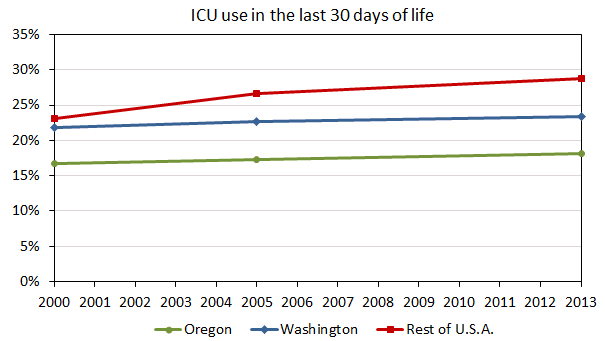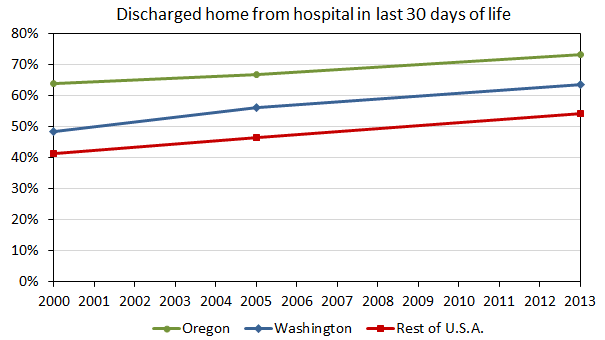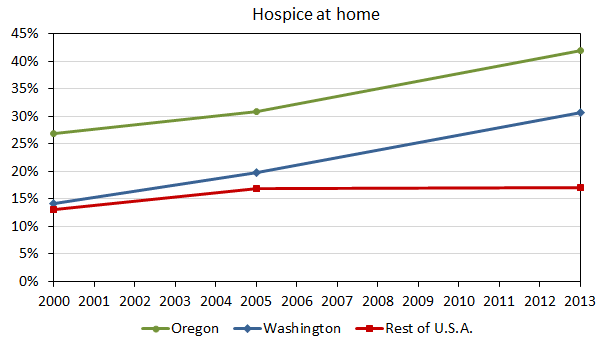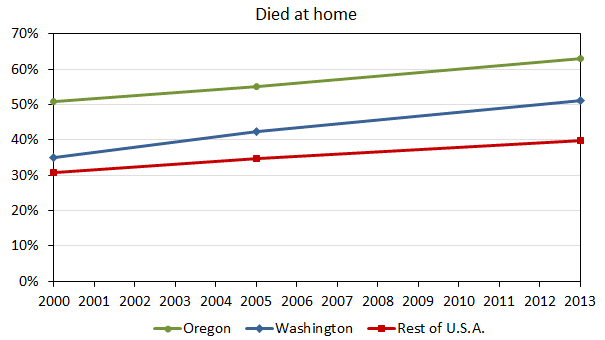Oregon and Washington show the way

A scientific study just published in the New England Journal of Medicine reveals that residents of both Oregon and Washington states, which legalised assisted dying in 1997 and 2008 respectively—as well as establishing formal advance directive programs—are far more likely to experience the kind of death they prefer, and with better access to palliative care, than is the average USA resident.1
It's well-established that most westerners would prefer to die peacefully at home rather than in a medicalised or other institutional setting. Yet it is recognised by doctors and families alike that there is a kind of medical ‘conveyer belt’ to acute care at the end of life that tends to shunt the dying individual through to ICU—a place where more and more burdensome medical interventions are administered with less and less likelihood that they’ll actually provide any benefit. These kinds of deaths, with vigorous and invasive procedures performed on a frail person approaching a natural death, can lead to longer and more complex bereavement recovery for surviving loved ones.
It’s also claimed by opponents of assisted dying law reform that assisted dying is a ‘competitor’ of palliative and hospice care, and that legalisation of assisted dying would result in the deterioration or at least stunting of palliative care services.
This latest study, including longitudinal data, provides further evidence that such claims are not only false, but that the legalisation of assisted dying improves the focus on all end of life decision making, whatever those decisions are.
Avoiding burdensome and questionable invasive care
Figure 1 shows that the ‘shunting’ of dying patients to ICU in the last 30 days of life is significantly lower in Oregon, which legalised assisted dying in 1997. Oregon also established a statutory comprehensive advance care directive (Physician Orders for Life Sustaining Treatment, or “POLST”) program earlier than other states, in 1993. Washington, which piloted a POLST program in 2000 and formally endorsed it in 2005 — and legalised assisted dying by ballot in 2008 — was already trending down from the national average (close to it in 2000), as public discussion of end of life decisions ratcheted up in the lead-up to reform. Since the POLST endorsement and ballot reform, Washington has continued to trend well below the national average.
Facilitating a non-institutionalised death
Figure 2 shows that both Oregon and Washington have continued to trend above the national average for facilitating patient wishes to die at home after a stay in acute care in the last 30 days of life.
Hospice care received at home
Figure 3 shows that by 2000, Oregon was already providing home hospice services at 2.1 times the national average, but that as the national average plateaued from 2005, the rate in Oregon continued to rise significantly, reaching 2.5 times the national average in 2013. To qualify for an assisted death, Oregon and Washington residents must be certifed by their doctor as expected to die within six months—which qualifies the patient for free hospice care.
Washington was close to the national average on the delivery of home hospice care prior to assisted dying law reform, beginning to deviate as conversations were held about permitting assisted dying and its POLST program was endorsed in 2005, increasing to 1.8 times the national average in 2013.
Death preferred at home
Figure 4 shows that both Oregon and Washington states continue to facilitate a private home-based death, according to patient and family wishes, at a rate considerably higher than the national average.
Conclusion
The results of this USA study mirror the kinds of findings from Dutch and Belgian research, which I have previously published,2 and another USA report from the Journal of Palliative Medicine which placed both Oregon and Washington amongst the top eight states for palliative care access in hospital settings.3 This study furthers these insights by showing that access to palliative care services in home settings is also significantly higher than the national average in Oregon and Washington.
Assisted dying opponents’ claims that legalising assisted dying would result in a deterioration or stunting of end of life decisions and in particular access to palliative care are contradicted by the data from lawful jurisdictions.
References
- Tolle, SW & Teno, JM 2017, 'Lessons from Oregon in embracing complexity in end-of-life care', New England Journal of Medicine, 376(11), pp. 1078-1082.
- Francis, N 2016, Assisted dying practice in Benelux: Whitepaper 1, DyingForChoice.com, viewed 13 Nov 2016, /resources/fact-files/assisted-dying-benelux-whitepaper-1.
- Morrison, RS, Augustin, R, Souvanna, P & Meier, DE 2011, 'America's care of serious illness: A State-by-State report card on access to palliative care in our nation's hospitals', Journal of Palliative Medicine, 14(10), pp. 1094-1096.

 Figure 1: ICU was used in the last 30 days of life
Figure 1: ICU was used in the last 30 days of life Figure 2: Patient was discharged from hospital in the last 30 days of life
Figure 2: Patient was discharged from hospital in the last 30 days of life Figure 3: Dying patient received hospice care at home
Figure 3: Dying patient received hospice care at home Figure 4: The individual died at home
Figure 4: The individual died at home